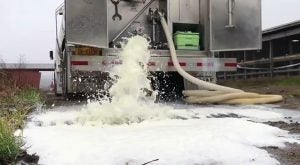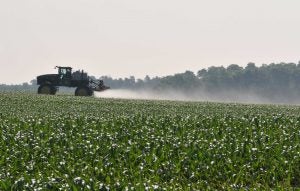How many times have you heard by now that 2020 has been a year like no other? From health and politics to economic factors and shifting sentiment, this year has been nothing short of a sensory overload for all industries, including agriculture. Farmers and ranchers, who are intimately connected to the public through the food supply chain, had front-row seats to some of the biggest challenges our society faced, but that certainly wasn’t all that was on the mind of our industry. The top agricultural stories of the year were as diverse as they were impactful.
While much of what happens in the society at large affects agriculture, there are many things that happen inside agriculture that feel almost unique to us — the kinds of things that create a shockwave within the farm sector may only be a minor ripple in places like Washington, D.C., or Los Angeles. We have things we care about more than anyone else does, and it’s those 2020 happenings that rise to the top of our list. They’re the agriculture stories of 2020 that captivated our beings, that had us obsessing on social media, that, sometimes, had us nervous about what was around the next corner.
Here, we dive into five of the most impactful 2020 events and stories, remembering how they shaped this year in agriculture and how they made us feel.

1. The COVID-19 pandemic and agriculture
There’s no surprise that this is at the top of the list. Coming into the closing weeks of 2020, the pandemic that originated late last year in China continues to impact at least 218 countries and territories worldwide. In all, more than 65.6 million cases have been documented, and that number seems to keep rising at an alarming rate, even though we close in on vaccine approvals from Pfizer and Moderna. As of now, the U.S. has logged more than 14.6 million cases, and is close to 300,000 related deaths.
The full impact of this virus has yet to be made clear, and it’s unlikely we’ll have answers about that any time soon. However, some of COVID-19’s impact on the agriculture sector was immediately visible in multiple ways, so we’ll separate this into two major fronts:
Closures at plants and other food-chain disruptions: Near the beginning of the virus’s appearance in the U.S., we saw a swift tumble in corn, cotton, and soybean futures. Ethanol plants became idled, while some fruit and vegetable farmers decided that their best option was to leave produce in the field. The same thing began happening on dairy farms, too, and the nation was forced to watch heartbreaking images of gallons of milk being dumped. Why, exactly? As state and local governments forced many businesses, restaurants, and schools to close through those first few months, many food items had lost their distribution channels. Yes, there was a switch to grocery store sales, but the supply-chain changeover couldn’t happen quickly enough. Many processing plants had to shutter as coronavirus cases spiked among employees, which significantly limited meat output, and packaging plants didn’t have the supplies on hand to individually package the growing amount of food and drink needed for retail locations rather than restaurants and schools. The logistics of it compounded the COVID nightmare that was already sweeping the nation.
Ag conferences and show events went virtual: Just weeks into the pandemic, it was becoming clear that social distancing and other preventive measures were going to be long lasting. In mid-April, the Junior Livestock Show of Spokane, Washington, announced that its annual event was going virtual, and as the year dragged on, that kind of decision became more and more common. Major shows, such as the Farm Progress Show and American Farm Bureau Convention, would announce virtual approaches, as did the National FFA Convention & Expo. Other event organizers, like for the upcoming World Ag Expo in early 2021, announced cancellations before backtracking and instead opting to attempt virtual shows. And being virtual affected agricultural education, with FFA and 4-H programs struggling through the broadband shortcomings of rural America and searching for ways to bring their students genuine and worthwhile experiences, even if not as collaborative and hands-on as in years past.

2. Burger King’s #CowsMenu Campaign
No issue inflamed the passions of farmers and ranchers on a wide scale as did the launch of Burger King’s disastrous #CowsMenu marketing campaign. A Burger King ad over the summer (spearheaded by Chief Marketing Officer Fernando Machado) was touted as trying to address sustainability and cattle emissions by feeding lemongrass to livestock, but the specific video ad also approached that topic by featuring kids in gas masks, a “redneck farmer” stereotype, and references to “cow farts.” It quickly became a source of scorn among the ag community for jumping the gun by marketing unproven science and for throwing current cattle production under the bus. Even people involved directly in the research lambasted BK’s delivery, and many farmers spoke up on social media calling for a boycott of the fast-food chain.
Machado found himself on the defensive for weeks to come, appearing on shows such as the What the Farm podcast and writing a public apology (which, itself, wasn’t always well received). The BK executive and others involved with the video ad spot made overtures toward rectifying their mistake and trying to understand the industry more, including going on a multi-farm tour with AGDAILY columnist and international ag speaker Michelle Miller (aka Farm Babe) and putting out a new video on social media showcasing some of what was learned. However, for many in agriculture, the damage had already been done and skepticism still remains.

3. Dicamba’s registration status
In June, farmers in the thick of the 2020 growing season were handed a huge question that no one at the time knew the answer to: What would be the fate of the herbicide dicamba? A judicial panel from the 9th U.S. Circuit Court of Appeals had put the brakes on the use of most dicamba products, stating that the U.S. Environmental Protection Agency “substantially understated risks and that it acknowledged and failed entirely to acknowledge other risks,” according to court documents. The ruling removed the registration for three out of four dicamba products on the market — Monsanto’s XtendiMax, DuPont’s FeXapan, and BASF’s Engenia. The only one not mentioned was Syngenta’s Tavium product.
The ruling was spurred by a lawsuit from four environmental activist groups — the National Family Farm Coalition, the Center for Food Safety, the Center for Biological Diversity, and the Pesticide Action Network North America — which wanted to force the EPA to cancel the approval of the weed killers. The fact that dicamba had a rocky history because of instances of drift and allegations of misuse surely didn’t help matters any. However, relief for many growers arrived in October, when the EPA pushed forward to allow the use of dicamba products on dicamba-tolerant cotton and soybeans. The governmental approval of the products come with new restrictions and will expire in 2025, but overall, American farmers have breathed a sigh of relief for the upcoming growing season and some years beyond.

4. International agriculture trade deals
Two major international trade deals were advanced in January — well before the coronavirus pandemic would infiltrate the general public’s consciousness. In the middle of January, President Donald Trump signed Phase One of the trade agreement with China, signaling a major step toward ending a two-year economic struggle between the two countries, which had heavily impacted U.S. agricultural products. Phase One was billed as a $200 billion deal overall, with China expected to purchase up to $50 billion worth of agricultural products in each of the two years that followed. It was widely celebrated by farm organizations, which had seen negotiations with China fizzle and restart in 2019 and tariff threats become commonplace. The ag industry even shouldered a halt by China of U.S. agricultural imports, which had many concerned for several months about the future of trade. Throughout 2020, after the Phase One deal was signed, the ag industry has pressed leaders to make sure that both nations are upholding their ends of the deal and that purchasing obligations are being met.
On January 29, Trump signed another trade pact: the United States-Mexico-Canada Agreement, better known simply as USMCA. This deal was seen as a major win for farmers and ranchers, as it was expected to increase agricultural exports from the U.S. by $2 billion and result in an overall increase of $65 billion in gross domestic product. Canada agreed to increase quotas on U.S. dairy products, benefiting American dairy farmers by $242 million, and would treat wheat imports the same as domestic wheat for grading purposes. Mexico agreed that all grading standards for ag products will be non-discriminatory. Despite the promises made, the COVID-19 pandemic threw much of this into disarray, and it’s unclear when the plans will naturally set in.

5. Perceptions of ag science
The science of agriculture has never been a strong suit for much of the public, and in a year when masks, hand-washing, social distancing, and vaccines were dividing many people, it’s no surprise that ag science again faced an uneven reception throughout the year. Yet, there was a major bright spot, which many hope will help bring plant engineering more to the forefront: the 2020 Nobel Prize in Chemistry was awarded in October to both Emmanuelle Charpentier and Jennifer A. Doudna, who discovered the CRISPR/Cas9 genetic scissors, one of gene technology’s sharpest tools and a vital piece in modern plant biotechnology. CRISPR is a household name in the recent years of agriculture, where it is used in the creation of genetically engineered foods and agricultural conservation.
However, for every amazing scientific breakthrough that is celebrated in mainstream media, there’s also major publications defending unscientific statements, such as activist farmer Joel Salatin calling coronavirus merely “a day of sniffles” or the tone-deaf decision by the Environmental Working Group to publish its much-maligned “Dirty Dozen” list amid a global pandemic. These kinds of efforts continue to taint food and agriculture’s scientific credibility and pigeon-hole the industry as either inept or uninformed … or both. And they’re catering to a public that has often been shown to not understand even what a pesticide is.
Thankfully, there were several redeeming moments for ag science, even if they didn’t rise to the level of national news: like the use of genetically engineered foods to help reduce climate concerns, the advancement of bioengineered Golden Rice for consumption, the research into the plant protein behind many food allergies, and the U.S. Food and Drug Administration launching the “Feed Your Mind” video series to help people understand the value of GMOs. These things suggest that much of the right message is making it out, even if it still has work reaching the food buyers and consumers it needs to.
Ryan Tipps is the managing editor for AGDAILY. He has covered farming since 2011, and his writing has been honored by state- and national-level agricultural organizations.



